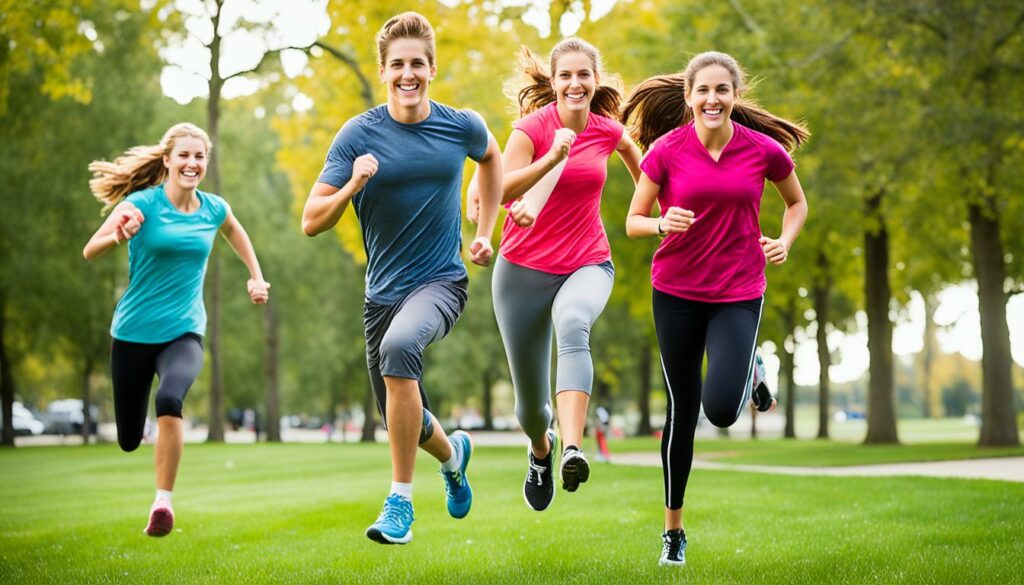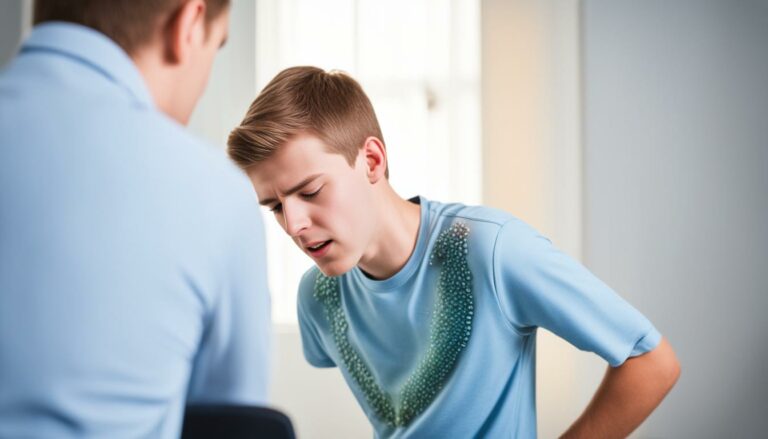Optimal Teen Fitness: How Much Physical Activity Do Teens Need
Physical activity is crucial for teenagers as it not only promotes physical health but also contributes to their overall well-being. Engaging in regular exercise helps teenagers maintain a healthy weight, strengthen their muscles and bones, boost their energy levels, and reduce stress and anxiety. However, it is essential to determine how much physical activity teens need to reap these benefits.
The Physical Activity Guidelines for Americans recommend that teenagers ages 6 through 17 years should aim for at least 60 minutes of moderate-to-vigorous physical activity daily. This can include activities like brisk walking, running, swimming, cycling, and playing sports. By meeting this recommended exercise duration, teenagers can enhance their fitness level and reduce the risk of various health conditions, including heart disease and obesity.
Key Takeaways:
- Teenagers should aim for 60 minutes or more of moderate-to-vigorous physical activity daily.
- Engaging in regular exercise promotes health, fitness, and overall well-being.
- Recommended activities include brisk walking, running, swimming, cycling, and playing sports.
- Meeting the recommended exercise duration helps reduce the risk of heart disease and obesity.
- Physical activity can help teens maintain a healthy weight, strengthen their muscles and bones, boost energy levels, and reduce stress and anxiety.
Importance of Physical Activity for Adolescents

Regular physical activity in childhood and adolescence is crucial for promoting lifelong health and well-being. Engaging in age-appropriate and enjoyable physical activities is key to keeping teenagers active and healthy. Not only does physical activity improve physical fitness, but it also has significant mental health benefits.
Studies have shown that regular exercise can help reduce symptoms of depression and anxiety in adolescents. Physical activity helps release endorphins, which are known as the “feel-good” chemicals in the brain. This can boost mood and overall well-being, providing a natural way to combat stress and improve mental health.
In addition to the mental health benefits, physical activity also enhances cognitive function. Regular exercise improves attention, concentration, and memory, which can positively impact academic performance. By incorporating physical activity into their daily routine, teenagers can enhance their cognitive abilities and improve their overall learning experience.
Furthermore, physical activity helps in the development of strong bones and muscles, which are especially crucial during adolescence. Regular exercise promotes bone density and muscle strength, reducing the risk of osteoporosis and other musculoskeletal conditions later in life.
Encouraging teenagers to be physically active not only sets them up for a healthier future but also teaches them valuable skills such as teamwork, discipline, and perseverance through sports and physical challenges. It promotes a positive body image and helps them foster a healthy relationship with their bodies, appreciating what they can do rather than focusing on appearance alone.
“Physical fitness is not only one of the most important keys to a healthy body, but it is also the basis of dynamic and creative intellectual activity.” — John F. Kennedy
It is essential to provide adolescents with a variety of physical activities to ensure they stay engaged and motivated. Activities such as team sports, dance classes, hiking, biking, and swimming can be excellent choices. Encouraging teenagers to try new activities and find something they enjoy can help create a lifelong habit of staying active.
The Benefits of Physical Activity for Adolescents:
- Improves physical fitness
- Reduces symptoms of depression and anxiety
- Enhances cognitive function
- Promotes bone and muscle development
- Teaches valuable life skills
- Fosters a positive body image
In conclusion, physical activity plays a central role in adolescent health and well-being. Not only does it improve physical fitness, but it also positively impacts mental health, cognitive function, and overall development. By promoting regular exercise and providing a supportive environment for physical activity, parents and caregivers can help teenagers establish healthy habits that will benefit them throughout their lives.
Recommended Physical Activity Levels for Teens

To promote optimal health and well-being, teenagers should aim for at least 60 minutes of moderate-to-vigorous physical activity on most days of the week. Engaging in regular physical activity helps teenagers maintain a healthy weight, build strong muscles and bones, improve cardiovascular fitness, and support overall mental health.
Teenagers have a wide range of activities to choose from to meet these recommended physical activity levels. Aerobic activities like brisk walking, running, swimming, cycling, and playing sports are fantastic options to get their heart rates up and improve endurance. It’s important to encourage teenagers to find activities they enjoy, as this will increase their motivation and make exercise a fun and sustainable part of their lives.
In addition to aerobic exercises, it’s also essential for teenagers to incorporate muscle-strengthening and bone-strengthening activities into their routines. This can include activities like push-ups, sit-ups, resistance training, weightlifting, and activities that involve jumping and running to promote bone health.
“Physical fitness is not only one of the most important keys to a healthy body, but it is also the basis of dynamic and creative intellectual activity.” – John F. Kennedy
By engaging in a variety of physical activities that target different aspects of fitness, teenagers can benefit from a well-rounded exercise routine. This not only enhances their physical health but also provides opportunities for personal growth, social interaction, and the development of important life skills such as teamwork and discipline.
Remember, the key is to encourage teenagers to find activities they enjoy and to make physical activity a regular part of their lives. By instilling healthy exercise habits during adolescence, we can set them up for a lifetime of well-being and ensure they reap the many benefits of an active lifestyle.
Benefits of Physical Activity for Teenagers

Regular exercise offers a wide range of benefits for teenagers, both in the short term and long term. Engaging in physical activity not only contributes to their overall health but also plays a significant role in their emotional well-being. Let’s explore some of the key advantages:
- Improved Blood Circulation: Physical activity helps to enhance blood flow throughout the body, promoting cardiovascular health and reducing the risk of heart disease.
- Maintains a Healthy Weight: Regular exercise helps teenagers maintain a healthy weight by burning calories and building lean muscle mass.
- Lower Cholesterol and Blood Pressure: Physical activity can help reduce levels of LDL cholesterol (the “bad” cholesterol) and lower blood pressure, reducing the risk of cardiovascular diseases.
- Stronger Muscles and Bones: Teenagers who engage in physical activities develop stronger muscles and bones, reducing the risk of osteoporosis and improving overall strength and coordination.
- Boosts Energy Levels: Exercise increases energy levels and stamina, allowing teenagers to perform better in daily activities and sports.
- Reduces Stress and Anxiety: Physical activity promotes the release of endorphins, which are natural mood boosters, helping teenagers manage stress and anxiety.
- Improves Sleep Quality: Regular exercise can improve the quality of sleep, leading to better concentration, mood, and overall well-being.
Moreover, it is worth highlighting that the benefits of physical activity during adolescence can extend into adulthood. By establishing healthy exercise habits at a young age, teenagers are more likely to continue engaging in physical activities as they grow older, leading to a more active and healthier lifestyle in the long run.
To further illustrate the numerous benefits of physical activity for teenagers, let’s take a look at the following table:
| Benefit | Description |
|---|---|
| Improved Cardiovascular Health | Regular exercise promotes better blood circulation, reducing the risk of heart disease. |
| Weight Management | Physical activity helps maintain a healthy weight by burning calories and building lean muscle mass. |
| Mental Well-being | Engaging in physical activity reduces stress, anxiety, and symptoms of depression, leading to better emotional well-being. |
| Stronger Muscles and Bones | Exercise strengthens muscles, improves bone density, and reduces the risk of osteoporosis. |
| Increased Energy Levels | Regular physical activity boosts energy levels and enhances overall stamina. |
| Improved Sleep Quality | Exercise promotes better sleep, leading to improved concentration, mood, and overall well-being. |
As you can see, physical activity offers a wide array of benefits that positively impact teenagers’ physical and mental health. Encouraging teenagers to engage in regular exercise is an investment in their long-term well-being.
Physical Activity Guidelines for Teens

The Physical Activity Guidelines for Americans recommend that teenagers engage in at least 60 minutes of moderate-to-vigorous physical activity daily. It’s important for teenagers to prioritize their physical well-being by incorporating regular exercise into their daily routine.
The Importance of Aerobic Activities
Aerobic activities are essential for teenagers as they help elevate the heart rate and increase cardiovascular fitness. Running, swimming, cycling, and playing sports are excellent choices for aerobic exercise. These activities not only keep teens active but also boost their endurance and improve overall health.
Image:
The Role of Muscle-Strengthening Exercises
In addition to aerobic activities, muscle-strengthening exercises should be included in teenagers’ exercise routine. These exercises help build and tone muscles, promote healthy growth, and enhance overall strength. Examples of muscle-strengthening exercises include push-ups, lunges, squats, and using resistance bands or weights.
The Benefits of Bone-Strengthening Exercises
Teenagers should also engage in bone-strengthening exercises to promote healthy bone development. Activities that involve impact or resistance, such as jumping, skipping, and playing basketball or volleyball, can help build strong bones and reduce the risk of osteoporosis later in life.
Summary: The Physical Activity Guidelines for teens recommend a minimum of 60 minutes of moderate-to-vigorous physical activity daily. This should include aerobic exercises to improve cardiovascular fitness, muscle-strengthening exercises for overall strength, and bone-strengthening exercises to promote healthy bone development.
Incorporating Exercise into Teenagers’ Lives
Encouraging teenagers to engage in physical activity is essential for their overall health and well-being. By providing opportunities for age-appropriate activities that they find enjoyable, you can help them develop a lifelong habit of regular exercise.
Here are some suggestions on how to incorporate exercise into teenagers’ lives:
- Join sports teams: Encourage your teenager to participate in team sports like soccer, basketball, or volleyball. Not only will they get their daily recommended physical activity, but they will also develop valuable skills and enjoy social interaction.
- Go for walks or bike rides: Plan family outings where you can all go for walks or bike rides together. This not only promotes physical activity but also strengthens family bonds.
- Participate in dance or fitness classes: Enroll your teenager in dance classes or fitness programs that align with their interests. This can be anything from Zumba to yoga or martial arts.
- Household chores: Assign your teenager tasks that involve physical exertion, such as mowing the lawn, gardening, or cleaning the house. This helps them stay active and contribute to the household responsibilities.
It’s crucial to limit sedentary activities like screen time and encourage an active lifestyle. Encourage your teenager to decrease the time spent watching TV or playing video games and replace it with physical activities they enjoy.
“Physical activity should be seen as a fun and enjoyable part of teenagers’ lives. By finding activities that they genuinely enjoy, you’re more likely to keep them engaged and motivated in the long run.”
Remember, incorporating exercise into teenagers’ lives is about making it a natural and enjoyable part of their routine. By providing support and creating a positive environment, you can help them develop healthy exercise habits that will benefit them throughout their lives.
Avoiding Excessive Exercise Among Teens
While regular exercise is essential for teenagers, it’s important to recognize that excessive exercise can have negative consequences for their physical and mental health. Compulsive exercising, often driven by body image concerns or eating disorders, can lead to a range of issues that pose risks to overall well-being.
Excessive exercise can result in overuse injuries such as stress fractures, muscle strains, and joint problems. By pushing themselves too hard without proper rest and recovery, teens may experience diminished athletic performance, chronic fatigue, and even severe exhaustion.
Additionally, intense exercise combined with restrictive eating patterns can lead to unintended weight loss, nutrient deficiencies, and disruptions in normal growth and development. Psychological effects may include obsessive thoughts about exercise, anxiety, and a negative impact on self-esteem.
To protect teenagers from the potential harm of excessive exercise, it’s crucial for parents and caregivers to be vigilant about monitoring their exercise habits. It’s essential to encourage a balanced approach to physical activity and educate teens about the importance of listening to their bodies, resting when needed, and maintaining a healthy relationship with exercise.
If parents suspect that their teenager is engaging in compulsive or excessive exercise, it’s crucial to seek professional help from a healthcare provider experienced in working with adolescents. They can provide guidance, support, and interventions to address any underlying issues and promote a safe and sustainable approach to fitness.
Listen to the Experts:
“While exercise is beneficial, we must ensure that teenagers are not pushing themselves beyond their limits. Monitoring their exercise habits and promoting a healthy balance is key to safeguarding their overall well-being.” – Dr. Sarah Thompson, Pediatrician
Remember, the goal is to promote a positive and sustainable approach to physical activity that enhances teens’ health and well-being without compromising their overall quality of life.
| Signs of Excessive Exercise: | Consequences of Excessive Exercise: |
|---|---|
|
|
|
|
Creating a Supportive Environment for Teen Fitness
To promote teenage fitness and encourage regular physical activity, it is important to create a supportive environment that fosters healthy habits. By implementing the following strategies, parents, caregivers, and educators can inspire teenagers to prioritize exercise and maintain an active lifestyle.
Be a Positive Role Model
Lead by example and demonstrate the importance of exercise in your own life. Engage in physical activities regularly and emphasize the positive impact it has on your physical and mental well-being. Your enthusiasm and commitment to fitness can motivate teenagers to follow suit.
Participate in Physical Activities as a Family
Encourage family members to engage in physical activities together. Plan outings such as hiking, biking, or playing a sport. Participating in activities as a family not only promotes bonding but also makes exercising more enjoyable for teenagers.
Limit Screen Time
Excessive screen time can hinder teenage fitness levels. Set limits on recreational screen time and encourage teenagers to engage in physical activities instead. Encourage them to find alternative hobbies that involve movement and exercise, such as learning a new sport or playing an instrument.
Discuss the Importance of Exercise
Have open conversations about the benefits of exercise and its impact on overall health and well-being. Explain how regular physical activity can improve fitness, boost mood, increase energy levels, and reduce the risk of chronic diseases. Encourage teenagers to ask questions and express any concerns they may have about exercise.
Address Body Image Concerns
Teenagers may have body image concerns that can influence their motivation to engage in physical activity. Foster a safe and non-judgmental environment where they can openly discuss their feelings and insecurities. Emphasize the importance of exercise for health rather than appearance, helping them develop a positive relationship with fitness.
“Creating a supportive environment plays a pivotal role in motivating teenagers to prioritize physical activity and make it a lifelong habit.” – Dr. Emily Johnson, Adolescent Psychologist
By implementing these strategies, parents and caregivers can create an environment that supports teenage fitness and encourages regular exercise. Remember that every small step towards an active lifestyle can have a significant impact on teenagers’ overall health and well-being.
Fun Ways for Teens to Stay Active
Encouraging teenagers to stay active is essential for their physical and mental well-being. By offering a variety of enjoyable activities, you can help them incorporate daily exercise into their routine. Here are some fun suggestions:
- In-line Skating: Get your teen rolling with in-line skating. It’s a great cardiovascular workout that also helps strengthen leg muscles.
- Skateboarding: Skateboarding is not only a thrilling sport but also an excellent way to improve balance and coordination.
- Basketball: Gather friends or join a local basketball team. Basketball is a fantastic team sport that enhances agility, endurance, and promotes teamwork.
- Swimming: Whether it’s swimming laps or playing water games, swimming is a low-impact exercise that works the entire body.
- Walking or Running with a Dog: Walking or running with a furry friend is a fun way to stay active and bond with your pet.
- Running Errands on Foot or by Bike: Encourage your teen to run errands on foot or by bike instead of relying on motorized transportation. It’s an eco-friendly way to stay active while getting things done.
- Recreational Sports or Hobbies: Explore recreational sports like soccer, volleyball, or tennis. Teens can also try out hobbies like dancing or gymnastics, which provide both physical and creative outlets.
By providing various options and allowing your teen to choose activities they enjoy, you can make daily exercise a fun and sustainable part of their lives. Remember to prioritize safety and ensure they wear appropriate protective gear for activities like in-line skating, skateboarding, or cycling.
Monitoring and Support for Teen Exercise Habits
As parents and healthcare providers, it is essential to keep a close eye on teenagers’ exercise habits to ensure they are maintaining a healthy level of physical activity.
Regular physical activity is crucial for teenagers’ overall well-being, promoting healthy growth and development. However, it is equally important to monitor their exercise routines to prevent any potential issues that may arise.
If a teenager’s exercise routine becomes excessive, interfering with their daily activities or causing weight loss and growth issues, it is crucial to seek professional help to address any underlying concerns.
Professional guidance can provide valuable insights into tailoring an exercise program that suits the teenager’s unique needs, ensuring they engage in a recommended amount of exercise without any negative consequences.
Signs of Excessive Exercise
Recognizing the signs of excessive exercise in teenagers is vital in identifying when professional help is needed:
- Sudden weight loss or drastic changes in weight – Unexplained weight loss or changes in weight can indicate excessive exercise and potential health risks.
- Obsession with exercise – Constantly talking about exercise, planning workouts excessively, and becoming preoccupied with physical activity can be signs of overexercising.
- Frequent injuries or fatigue – Experiencing recurrent injuries, excessive fatigue, or extended recovery times may indicate that the exercise routine is too intense or not allowing sufficient rest and recovery.
By staying mindful of these warning signs and having an open line of communication with teenagers about their exercise habits, parents and healthcare providers can provide the necessary support and guidance for a healthy and balanced approach to physical activity.
Conclusion
Regular physical activity is crucial for the overall health and well-being of teenagers. By adhering to the recommended exercise guidelines, parents and caregivers can help their teens maintain a healthy lifestyle and reduce the risk of various health conditions. It is important to prioritize the importance of physical activity for adolescents and provide them with opportunities to engage in enjoyable activities.
By dedicating at least 60 minutes a day to moderate-to-vigorous physical activity, teenagers can improve their physical fitness, cognitive function, and mental health. Participating in aerobic, muscle-strengthening, and bone-strengthening exercises can have numerous benefits, including improved cardiovascular health, weight management, increased energy levels, and reduced stress and anxiety.
To ensure that teenagers stay active and fit, it is essential to create a supportive environment that promotes physical activity. This can be achieved by being a positive role model, limiting sedentary activities, and encouraging open communication about the benefits of exercise. By incorporating fun and diverse activities into their daily routine, teenagers can develop healthy habits that will benefit them throughout their lives.
FAQ
How much physical activity do teens need?
The Physical Activity Guidelines for Americans recommend that teenagers engage in at least 60 minutes of moderate-to-vigorous physical activity daily.
Why is physical activity important for adolescents?
Regular physical activity in childhood and adolescence promotes lifelong health and well-being. It improves physical fitness, mental health, and reduces the risk of various health conditions.
What are the recommended physical activity levels for teens?
Teenagers should aim for at least 60 minutes of moderate-to-vigorous physical activity on most days of the week.
What are the benefits of physical activity for teenagers?
Regular exercise for teenagers improves blood circulation, helps maintain a healthy weight, lowers cholesterol and blood pressure, strengthens muscles and bones, boosts energy levels, reduces stress and anxiety, and improves sleep quality.
What are the physical activity guidelines for teens?
The Physical Activity Guidelines for Americans recommend that teenagers engage in at least 60 minutes of moderate-to-vigorous physical activity daily, including aerobic, muscle-strengthening, and bone-strengthening exercises.
How can exercise be incorporated into teenagers’ lives?
Teenagers can engage in various enjoyable activities like brisk walking, running, swimming, cycling, playing sports, dancing, or participating in fitness classes to meet the recommended daily exercise goals.
How can excessive exercise be avoided among teens?
It is important to monitor exercise habits and be aware of compulsive exercising, which can lead to injuries, weight loss, and negative impacts on overall well-being. Seeking professional help is necessary if any concerns arise.
How can a supportive environment be created for teen fitness?
By being a positive role model, participating in physical activities as a family, limiting screen time, and discussing the importance of exercise, a supportive environment can be fostered.
What are some fun ways for teens to stay active?
Teens can engage in activities like in-line skating, skateboarding, basketball, swimming, walking or running with a dog, running errands on foot or by bike, and participating in recreational sports or hobbies like dancing or gymnastics.
How should teen exercise habits be monitored and supported?
It is important for parents and healthcare providers to monitor exercise habits and ensure a healthy amount of physical activity. Seeking professional help is necessary if necessary concerns arise.
How does regular physical activity benefit teenagers?
Regular physical activity plays a vital role in the overall health and well-being of teenagers. It promotes a healthy lifestyle, prevents the risk of health conditions, and builds lifelong habits for a healthy future.







